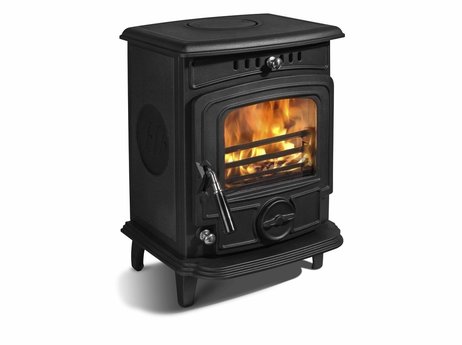Operating & Maintaining your StoveMany solid fuel appliances are expected to work 24 hours a day keeping us warm and supplied with constant hot water (that's if you have purchased a boiler stove).
However, like any other machine, they work better and last longer when correctly installed, burn the right fuel and are properly maintained. We strongly recommend installation of CO alarms & fire extinguisher where the Stove is placed. |
Fire Door / WindowDoors should be tight fitting. Many doors will have heat proof seals to aid a gas tight seal. This seal is subject to wear and tear and will need to be replaced when its effectiveness is reduced. Using a stove with its doors open will reduce efficiency and with some designs may result in over firing and damage to the appliance. Excess air intake will cool the fire and draw cold air into the house.
Ash Pan
Most stoves incorporate a pan to collect ashes as they are produced from burning fuels and fall through the grate, allowing easy removal.
|
Primary AirPrimary air enters the appliance below the grate and the control is often in the ash pit door. This controls the burning rate of the fire. Please see your appliance's instruction manual for correct operation.
Fire Brick
Many solid fuel appliances have fire bricks lining the floor and walls. Their purpose is to help insulate the fire bed, improving the stove's efficiency by retaining heat. Broken fire bricks should be replaced immediately.
|
Secondary AirSecondary air enters from above the grate and provides oxygen for the secondary combustion of gases and vapors during the primary combustion. This helps combustion efficiency so that smoke emission is minimized.
Flue Outlet
The flue outlet is generally situated on either the top or the rear of the stove. Combustion gases leave the stove through this outlet to be carried to the chimney through a connecting pipe. The gases eventually safely leave the dwelling at the top of the chimney.
|
Throat PlateSoot can fall down the flue and collects on the throat plate. This needs clearing to reduce the risk of these deposits igniting and to ensure that there is a clear flue way for smoke to leave the appliance
Appliance Controls
The main controls on a stove are for regulating the flow of air reaching the fuel, which in turn will affect the heat output and the efficiency of burning. Instruction manuals usually show how to operate the controls to achieve the best combustion and efficiency. You may find a flue pipe temperature gauge helpful to set the controls for your appliance.
|
Burn Efficiency - What to look for
In the first instance always refer to your stove instruction manual. The following can be used as general guidelines. An efficient burn of fuel providing heat to the room requires three things:
|
Time
|
Temperature
|
Turbulence
|
|
The burning should have time to happen within the appliance before the combustion air pushes the smoke up the chimney, draught increases and stabilizes and the appliance is hot to touch.
|
Solid fuel burns efficiently at a high temperature giving rise to negligible smoke. If the temperature is insufficient then much of the potential heating value of your fuel will be lost and increased smoke will be discharged from the flue.
|
Arrange the fuel in a way which ensures the air and combustion gases mix for an efficient burn, taking care to not over fill the appliance.
|
The Flame picture in a healthy fire will be somewhere between
|
Vigorous Flame
|
Lazy Flame
|
Red Hot Embers
|
|
Just reaching the exit of the appliance (noticeable when getting the appliance up to temperature, but shouldn't be maintained)
|
That moves across the whole space within the stove (very efficient when up to temperature)
|
Very efficient, but may need more fuel before the embers die down
|
Lighting a Wood Burning Stove
Start with scrunched-up newspaper or a fire-lighter with a small amount of kindling. If you don't have a fire lighter first light up a bit of newspaper (no kindling) - keep both the air controls fully open, keep the door ajar half an inch and burn the newspaper - you will hear a 'whoosh' when the paper burns out - that means that stagnant air in the chimney or flue has been pushed out. Hint: cold air is heavy. Then add newspaper and kindling and light again. If you have a fire-lighter then you can start with kindling straight away. Once the kindling is well lit, add a couple of smaller logs, close the door and let the logs flame up. Then start reducing the air intake and maintain the fire frequently with small amounts of additional fuel. Never fill the chamber with logs. Never add petroleum & wax & similar fuels.


